- Home
- How natto is made
Natto can be described as the “food which is made of boiled soybeans with natto yeasts growing on the surface, producing very unique sticky paste called the ‘strings of natto’ and special flavor of natto.” When they grow, natto yeasts make it nutritious food by dissolving proteins in soybeans for their easy absorption, while creating various vitamins and enzymes.
The fermentation process of natto is short unlike that of miso bean paste or soy source. The fermentation of natto takes only about 20-22 hours from the start. From the start of processing to shipment, it is about 3 days at shortest.
Now, let’s see the manufacturing process of natto.
Soybean The Ingredient
Soybeans for natto vary in size from super large to tiny ones; in many cases, small and tiny ones are used. People prefer natto made of small or tiny beans presumably because when rice grains and natto beans are not much different in size, natto is easy to be mingled with rice and pleasant to the taste. Moreover, the smaller soybeans are, the larger their surface area becomes, which in turn means more sticky paste and delicious flavor natto produces, and therefore, likely to taste better.

Soybeans for natto
Washing
Soybeans, the ingredients of natto, go through the sorting machine to eliminate worm-eaten beans, cracked beans, colored beans, and foreign substances. They are then washed in the bean-washing machine to wash away by water soil, tiny filth and the like attached to the skin of soybeans.
Soaking in water
Cleanly washed soybeans are soaked in water. The process is called Shinseki (soaking and immersing). By making soybeans absorb enough water, it will make soybeans easy to be heated in the next steaming and boiling process, and thus ensuring soybeans to be boiled with even flavor and softness.
With enough water absorbed, soybeans become 2-2.3 times heavier than before water-absorption.

Soaked soybean for Natto
-
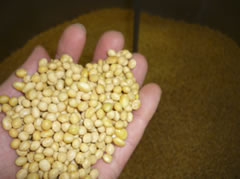
Before soaking in water
-

After soaking in water
Soaking time differs widely, depending on the water temperature. In winter when the water temperature is low at about 15 degrees Celsius, around 17-18 hours is a rough guide. When the temperature becomes higher at about 25 degrees Celsius in summer, around 7-8 hours is said to be a rough guide. Water should be somewhat large in quantity (more than three times the weight of soybeans). The soaking time needs to be adjusted according to the variety and the size of beans as well.
-

Pouring water into machine
-
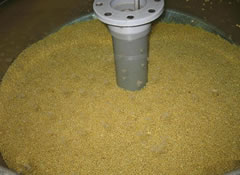
Soaking soybean for natto
Steaming
After absorbing enough water, soybeans undergo steaming in a pressure cooker.
Pressure cooker
Steaming kills various bacteria attached to the surface of soybeans. Moreover, soybeans become soft and full, which is the condition easy for natto yeasts to take nutrition and grow. Furthermore, steaming makes soybeans easy for various enzymes produced by natto yeasts to penetrate and dissolve the ingredients.
As for the time and temperature of steaming, each natto maker uses its ingenuity according to the variety and origin of soybeans in order to prepare good boiled beans.
Spraying of natto yeasts
Purely cultured natto yeasts are sprayed onto the boiled soybeans - after the steaming - to stick on their surface. In order to prevent the contamination of bacteria, it is ideal to spray with the temperature of boiled beans at about 70-90 degrees Celsius.
-

Spraying natto yeasts to soybean
-

Packing of fermentation container
There are a variety of fermentation containers including Styrofoam ones, paper cups, plastic bags, and ones of paper-thin sheet of wood.
In either case, as with the process of natto yeast spraying, boiled beans are packed in the container with due attention paid to do so while they are still hot in order to avoid the contamination of bacteria. Natto yeasts need oxygen to grow. Therefore, for the good passage of air to facilitate natto yeasts to grow, soybeans should not be packed too tightly so that they can have appropriate space among them. The bottom of natto containers on the market has a rough shape reflecting such consideration.

Manual packing by cup
PSP tray packing line
-

Manual packing by straw wrapper
-
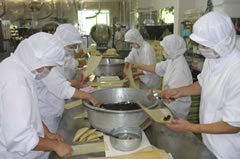
Manual packing by a paper‐thin sheet of wood
Fermentation
Soybeans are fermented in the fermentation container by placing them in the fermentation room at the temperature of 38-42 degrees Celsius for fully 16-24 hours.
-

Fermentation room -

Natto in the fermentation room
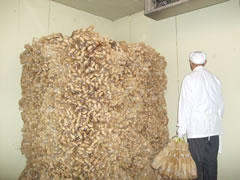
Straw wrapped natto in the fermentation room
After 16-24 hours, all products are taken out of the room for cooling to stop the fermentation as well as for dehumidification. It also has the effect of removing the metabolic gas. After the products are cooled down to the room temperature, they are moved to the refrigerating room.
Other containers such as paper cups, plastic bags and paper-thin sheet of wood ones are less effective than Styrofoam containers in keeping it warm and leak the heat generated by natto yeasts; therefore, the temperature of soybeans does not rise so much. As a result, natto yeasts grow less vigorously, enzymes produced do not work well, and sufficient fermentation does not happen.
Because of that, we adjust the temperature and humidity of the fermentation room depending on fermentation containers.
Maturation
Following the fermentation, after the temperature of the product is down to about that of the room, natto is refrigerated, and natto yeasts which have been increased by the fermentation are put to rest. This is called maturation.
Maturation is usually done at a low temperature of 5 degrees Celsius or under. And sufficient care is taken to prevent the product temperature from rising so that natto yeasts will not grow again during the wrapping and sorting processes. This temperature control from fermentation to maturation decides as to whether we are successful in making natto or not.
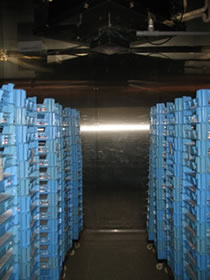
Natto palaced in the refrigerator to wait for wrapping and shipment
Wrapping
Packed in a container and fermented, natto is shipped with a label on it. Most Styrofoam containers are wrapped in two to three layers, while cup containers in a three-piece shrink-wrapping.
Wrapped products are packed in carbon boxes, and placed again in the refrigerator to wait for shipment.
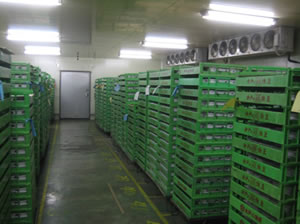
Natto palaced in the refrigerator to wait for shipment
Shipment
Fresh and safe natto is delivered to retail stores in the refrigerator car. At factories of natto producers, the temperature is strictly controlled in making natto. Refrigerating products in preparation for shipment is also very carefully handled in order to prevent re-fermentation.
Moreover, if the temperature of products rises during transportation, natto yeasts will start working again, which leads to deterioration of quality with the generation of ammonia smell etc. Therefore, refrigerator or freezer cars are used for transportation, so that product quality does not deteriorate. We deliver to you with utmost care.
-
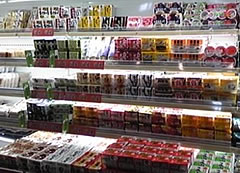
Natto placed on the refrigerated display case
-
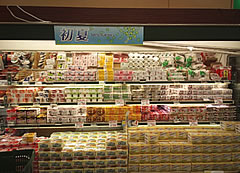
Natto section in the store







